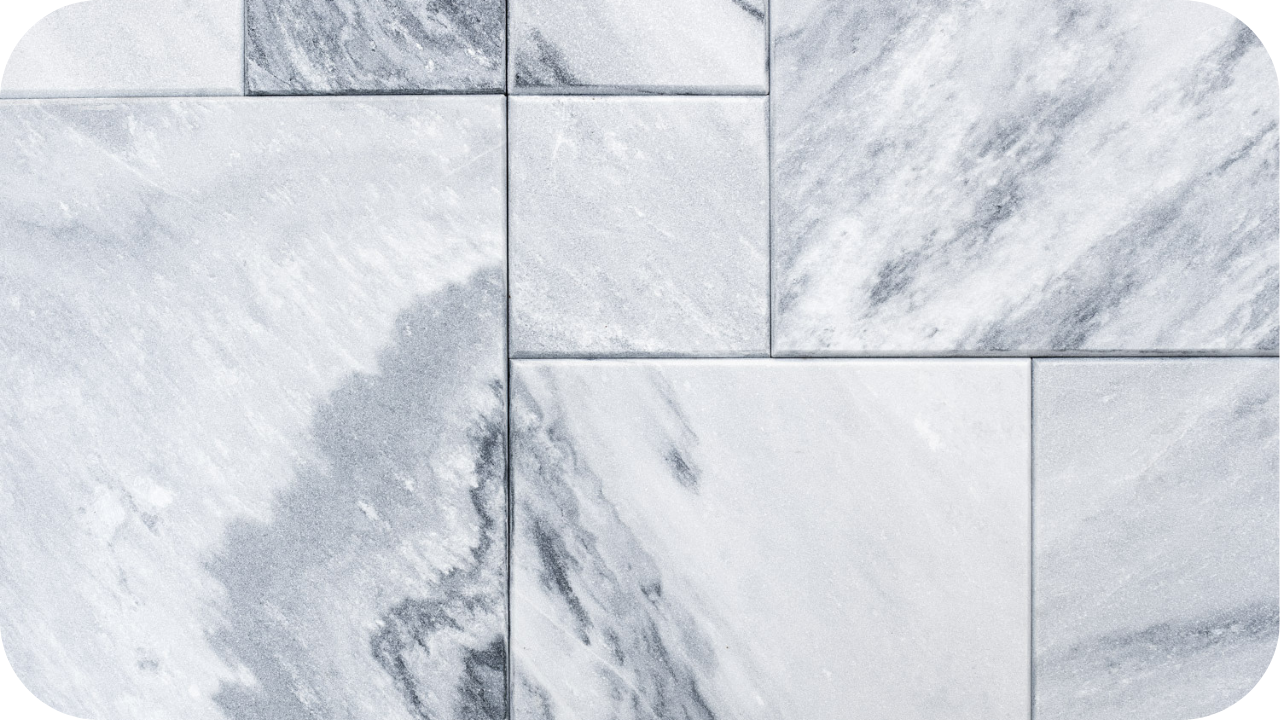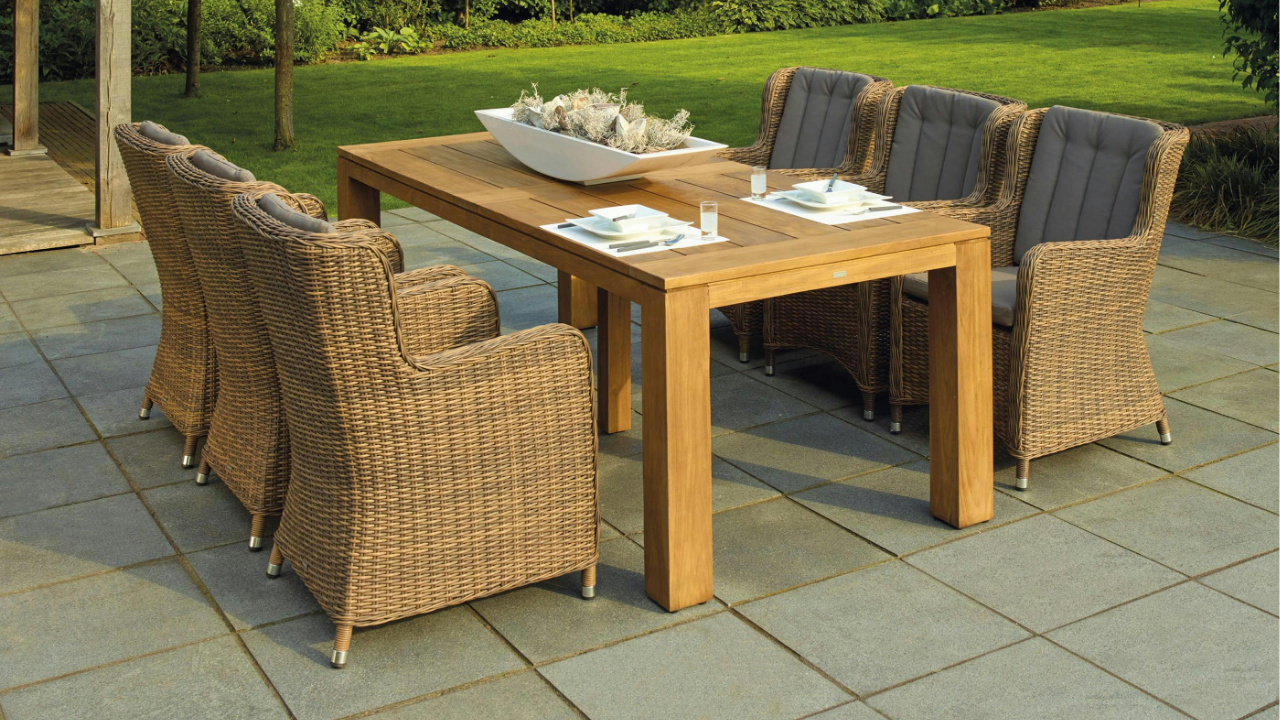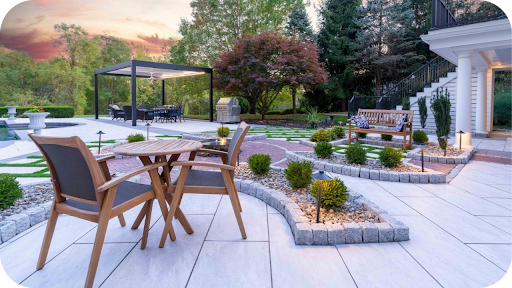
Marble is a luxurious natural stone renowned for its elegant veining and polished appearance, making it ideal for both walling and paving applications.
Its versatility and timeless beauty make it a highly sought-after choice for a variety of projects, from indoor spaces to outdoor features. With its classic appeal and durability, marble adds sophistication to any space.
In this article, we’ll discuss what marble is, how it forms, its key characteristics, and the benefits of using marble for paving and walling applications.
What Is Marble?
Marble is a metamorphic rock formed when limestone undergoes high pressure and temperature over millions of years. This process recrystallises the calcite in the limestone, creating a denser stone with unique veining patterns. The result is a stone with a distinctive appearance, strength, and durability, making it highly prized in construction and design.
Key Characteristics of Marble
Marble is a unique and versatile natural stone known for its distinct properties that set it apart from other materials. Here’s what makes marble stand out:
1. Elegant Veining and Polished Appearance
Marble features distinctive veining, caused by the presence of impurities during its formation. These veins can vary in colour and pattern, giving each piece a unique appearance. The polished surface enhances these natural features, giving the stone a shiny finish.
2. Available in a Range of Colours
Marble naturally occurs in a variety of colours, including white, grey, cream, black, green, and pink. These colours result from the mineral content within the stone, making each type of marble unique in its appearance.
3. Softer and More Porous Than Granite
Compared to granite, marble is softer and more porous. This means it can be more easily cut and shaped, but it also makes marble more susceptible to scratches, stains, and damage if not properly sealed.
4. Natural Texture and Density
Marble has a dense and fine-grained structure that contributes to its weight. The texture can vary based on the formation process, with some types being smoother while others have a more granular or rough texture, adding variety to its appearance.
5. Naturally Cool to the Touch
Due to its density and thermal properties, marble remains naturally cool to the touch, which is why it’s often used in hot climates or areas where a cooler surface is beneficial. This property also contributes to its comfort when used underfoot.
Popular Marble Varieties and Finishes for Timeless Paving and Walling Solutions
Marble offers a variety of types for both walling and paving. These unique varieties, paired with finishes, enhance the aesthetic and durability of your project.
- Maya Blue Marble: Maya Blue marble offers a sophisticated blue-grey tone. The honed finish enhances its subtle veining, perfect for high-end paving areas.
- Ocean Grey Marble: Ocean Grey marble features a deep grey base with light grey veining. Available in a polished finish, it’s ideal for sleek, modern spaces.
- Atmos Marble: Atmos marble is known for its soft beige and cream veining. The tumbled finish gives it a rustic, natural look, ideal for courtyards.
- Provincial Marble: Provincial marble presents warm beige hues with darker veining. The brushed finish offers a textured surface, perfect for outdoor spaces.
- Luna Grey Marble: Luna Grey marble has light grey tones with soft veining. A polished finish brings out its natural depth, perfect for high-traffic areas.
- Atlantic Marble: Atlantic marble has blue-grey hues with dark veining. A honed finish reveals its organic texture, ideal for modern and traditional outdoor paving.
- Verde Marble: Verde marble features green tones with white veining. Its natural split finish enhances the earthy appeal, ideal for unique paving projects.
- Olympus Marble: Olympus marble offers a striking contrast of white and grey veining. The polished finish accentuates its reflective quality, perfect for premium paving.
- Glacier Marble: Glacier marble has an icy white base with subtle grey veining. Its sawn finish provides a smooth surface, perfect for high-end paving projects.
Common Applications of Marble
Marble is a versatile stone, ideal for a range of applications, both indoors and outdoors. Here’s how this elegant material enhances spaces with functionality and beauty:
1. Indoor Flooring
Marble is a popular choice for indoor flooring in spaces like hallways, foyers, bathrooms, and kitchens. Its smooth, polished surface adds luxury and sophistication, while its durability ensures long-lasting performance in high-traffic areas.
4. Feature Paving
Marble is often used in courtyards, patios, and formal garden paths, especially in low-traffic areas. Its elegant and timeless appearance adds a high-end aesthetic to outdoor spaces, creating a sense of luxury and refinement.
2. Wall Cladding
Marble wall cladding is used to create stunning feature walls or fireplace surrounds. Its reflective surface enhances the light in any room, adding elegance and timeless beauty to both modern and traditional interiors.
3. Benchtops and Vanities
Marble benchtops and vanities are highly sought after for their luxurious appearance and unique patterns. Its natural beauty makes it perfect for creating eye-catching kitchen and bathroom surfaces that are both functional and elegant.
5. Sculptural Features
Marble is a preferred material for sculptures, fountains, columns, and garden features. Its workability and timeless beauty make it ideal for creating detailed and long-lasting art pieces that add character and charm to any landscape.
Why Choose Marble? Benefits for Design and Elegance
Marble is a timeless material that brings both elegance and functionality to any design. Here’s why marble is the ideal choice for enhancing both aesthetics and performance in your space.
1. Luxurious and Timeless Appearance
Marble’s natural veining and polished surface add sophistication and elegance to any space. Its timeless beauty enhances both classic and modern designs, making it an enduring choice for interior and exterior projects alike.
2. Adds Real Estate Value and Architectural Prestige
Marble elevates the overall aesthetic of a property, contributing to higher real estate value. Its association with luxury and fine craftsmanship enhances the architectural prestige of homes, offices, or commercial spaces.
3. Suits Both Classic and Modern Interiors
Marble complements a wide range of design styles. Whether used in traditional or contemporary spaces, marble’s natural beauty fits seamlessly into any decor, adding a touch of elegance to both minimalist and ornate settings.
4. Naturally Cool, Ideal for Indoor Flooring in Hot Climates
Due to its dense structure, marble remains cool to the touch, making it ideal for flooring in warmer climates. This inherent property helps maintain comfortable indoor temperatures, offering relief during the heat of summer.
5. Wide Variety of Colour Tones and Patterns
Marble comes in a wide array of colour tones and patterns, ranging from classic whites and greys to bold reds, greens, and blacks. This diversity makes it easy to find the perfect marble for any design vision.
Maintenance and Care for Marble
Marble is a low-maintenance stone, but proper care is essential to maintain its beauty and longevity. Here are key maintenance tips to keep your marble surfaces looking pristine.
- Seal Regularly: Seal marble surfaces every 1–2 years to protect against stains, moisture, and etching. Sealing helps maintain its polished appearance and prevents damage from spills or acidic substances.
- Clean with pH-Neutral Cleaners: Use mild, pH-neutral cleaners specifically designed for stone. Avoid acidic cleaners like vinegar or lemon, which can damage the surface and erode the stone.
- Blot Spills Immediately: Clean spills immediately, especially from acidic substances like wine, coffee, or juice. Blot the area with a soft cloth to prevent stains from setting into the stone.
- Dust and Sweep Regularly: Dust and sweep marble floors and surfaces regularly to prevent dirt and debris from scratching the surface. A soft broom or microfiber cloth is ideal for cleaning.
- Polish to Restore Shine: Over time, marble can lose its shine. Use a marble polishing cream to restore the gloss and enhance its natural beauty. Avoid using abrasive pads that could scratch the surface.
- Avoid Harsh Chemicals: Never use bleach or harsh chemicals on marble. These can cause damage to the surface and strip away the protective sealant. Stick to stone-specific cleaners for the best results.
- Use Coasters and Mats: To protect marble from scratches and stains, always use coasters for drinks and mats for high-traffic areas. This is especially important in kitchens and bathrooms where marble is exposed to water and spills.
Conclusion
Marble is a durable, elegant stone that adds timeless beauty to any space. With proper care, including regular sealing, cleaning with pH-neutral products, and quick spill management, you can maintain its shine and functionality for years.
For expert advice, premium marble varieties, and professional installation, contact Splendour in Stone to bring the elegance of marble to your next project.
More To Explore

Top 10 DIY Projects to Upgrade Your Backyard
More homeowners are paying attention to their outdoor spaces as backyards become important living areas. This shift highlights a desire for comfort, better use of

What Are the Best Permeable Pavers for Drainage?
Heavy rain can quickly turn a beautiful outdoor space into a frustrating pool of standing water. Many homes face similar drainage issues, especially in high-traffic


